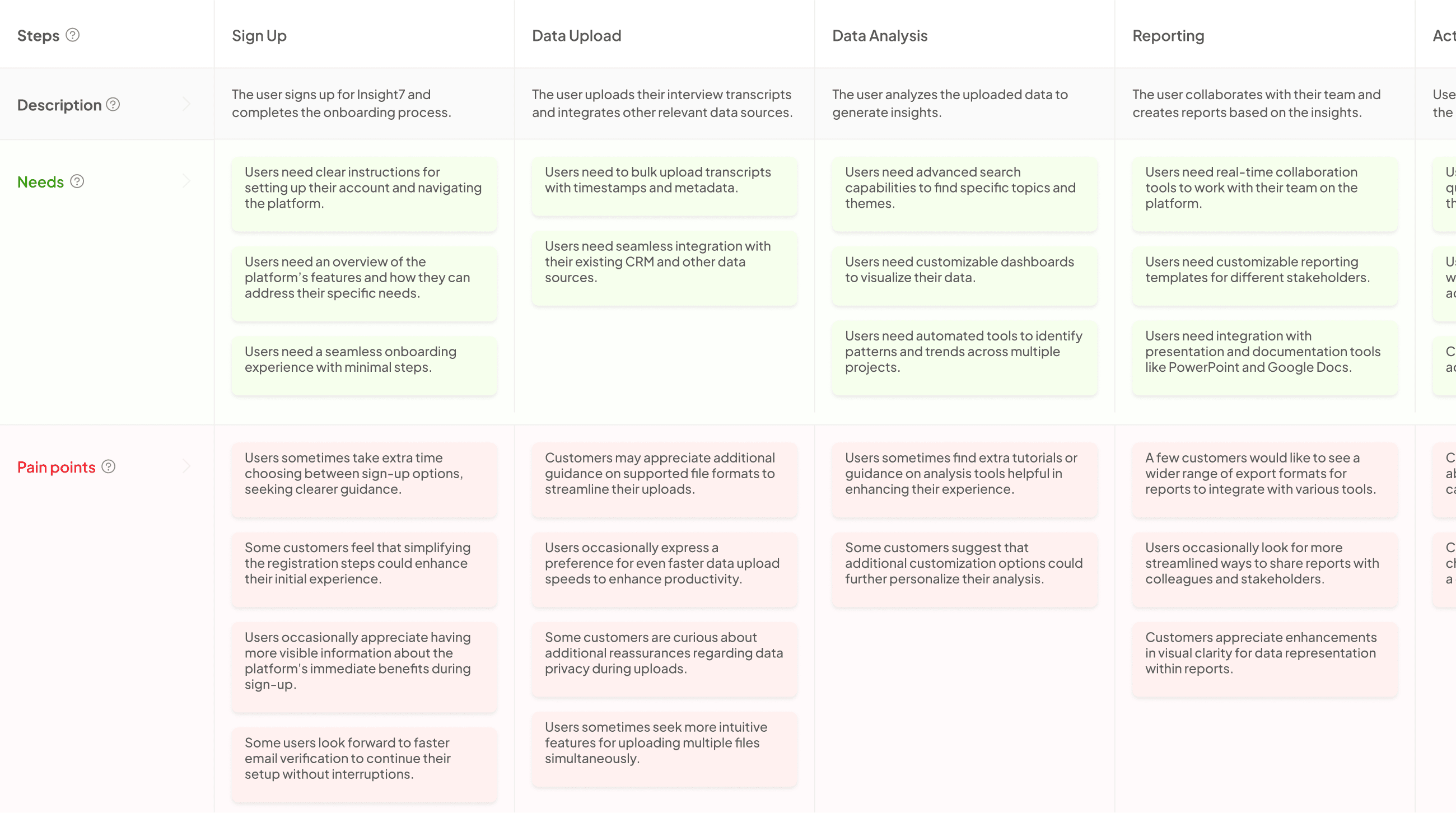User Journey Maps: How To Use AI to Create Templates
-
Hello Insight
- 10 min read


Understanding and optimizing user journeys is crucial for the success of any digital product or service. User journey maps are essential tools for businesses looking to understand and improve their customer experiences. These visual representations detail the steps a customer takes when interacting with a company, from the initial awareness phase to post-purchase engagement. The advent of Artificial Intelligence (AI) has streamlined the creation of these maps, making the process more efficient and insightful. This article delves into how AI can be leveraged to develop user journey map templates, with a subtle focus on tools that can facilitate this process.
Extract insights from Customer & Employee Interviews. At Scale.

The Basics of User Journey Maps
A user journey map provides a comprehensive visualization of the customer experience, highlighting critical elements such as:
- Stages: Different phases the customer goes through, including awareness, consideration, purchase, and post-purchase.
- Touchpoints: Specific interactions or points of contact between the customer and the brand, such as website visits, customer service calls, or social media interactions.
- Actions: The activities or steps the customer takes at each touchpoint.
- Emotions: The feelings or thoughts a customer experiences throughout their journey.
- Pain Points: Challenges or issues the customer encounters along the way.
Understanding these components helps businesses identify areas for improvement, enhance customer satisfaction, and tailor their strategies to meet customer needs.
The Role of AI in Creating User Journey Maps
AI has revolutionized the creation and utilization of user journey maps through advanced data analysis, pattern recognition, and predictive analytics. Here’s how AI enhances the process:
1. Efficient Data Collection and Analysis
AI can process vast amounts of data from various sources, including customer feedback, website analytics, and social media. By analyzing this data, AI identifies patterns in customer behavior, preferences, and pain points, providing a solid foundation for creating user journey maps.
2. Personalized Segmentation
AI enables businesses to segment users based on demographics, behavior, and preferences. This allows for the creation of personalized journey maps that reflect the unique experiences of different customer groups, ensuring relevance and actionability.
3. Sentiment Analysis
AI-powered sentiment analysis interprets textual data from reviews, social media posts, and other sources to gauge customer emotions at various touchpoints. This analysis helps businesses understand the emotional landscape of their customers, identifying both positive and negative experiences.
4. Predictive Analytics
AI’s predictive capabilities can forecast future user behaviors and trends, helping businesses anticipate customer needs and adjust their strategies accordingly. This foresight is crucial for optimizing the customer journey and enhancing overall satisfaction.
5. Automated Template Creation
AI can automate the creation of user journey map templates, streamlining the process and allowing teams to focus on strategic improvements. By generating templates based on predefined criteria, AI ensures consistency and efficiency in the mapping process.
Creating User Journey Map Templates Using AI
To effectively use AI in creating user journey map templates, follow these steps:
1. Set Clear Objectives
Begin by defining the goals of your user journey map. Are you aiming to improve customer satisfaction, increase conversion rates, or identify pain points? Clear objectives will guide the data collection and analysis process, ensuring that the map serves its intended purpose.
2. Gather and Integrate Data
Collect data from various sources, such as customer feedback, web analytics, CRM systems, and social media. AI tools can integrate these data points, providing a comprehensive view of the customer journey.
3. Segment Your Audience
Utilize AI to segment your audience into distinct groups based on demographics, behavior, and preferences. This segmentation allows for the creation of customized journey maps, providing more relevant and actionable insights.
4. Identify Key Touchpoints and Stages
Determine the key touchpoints and stages in the customer journey. AI can analyze data to identify critical interactions that significantly impact the user experience. These touchpoints may include website visits, email interactions, customer service contacts, and social media engagements.
💬 Questions about User Journey Maps: How To Use AI to Create Templates?
Our team typically responds within minutes
5. Analyze Emotions and Sentiments
Use AI-powered sentiment analysis to understand customer emotions at various touchpoints. This analysis can reveal pain points and positive experiences, providing a deeper understanding of the customer journey.
6. Generate and Customize Templates
AI can automatically generate user journey map templates, making the process efficient and scalable. Customize these templates to align with your specific business needs and objectives, ensuring that they include relevant stages, touchpoints, actions, emotions, and pain points.
7. Visualize the Journey
Visualization is crucial for effective communication. Use charts, graphs, and diagrams to create a clear and engaging user journey map. This visual representation helps stakeholders understand the customer experience and identify areas for improvement.
8. Test and Refine
Validate the AI-generated journey maps with real user data to ensure accuracy and relevance. Collect feedback and refine the templates as needed, making adjustments based on the latest insights and user behavior trends.
9. Implement Insights and Monitor Impact
Use the insights gained from the journey maps to implement changes that enhance the customer experience. Monitor the impact of these changes and update the maps regularly to reflect evolving customer behaviors and preferences.
Benefits of Using AI for User Journey Maps
Incorporating AI into the creation of user journey maps offers several benefits:
- Efficiency: Automation reduces the time and effort required to create journey maps, allowing teams to focus on strategic initiatives.
- Accuracy: AI processes large datasets, providing precise and reliable insights into customer behaviors and preferences.
- Personalization: AI enables the creation of tailored journey maps for different user segments, enhancing the relevance and impact of the insights.
- Predictive Capabilities: AI’s predictive analytics help businesses anticipate future trends and customer needs, enabling proactive adjustments.
- Data-Driven Decisions: AI provides actionable insights, supporting data-driven decision-making and strategic planning.
Generate Journey maps, Mind maps, Bar charts and more from your data in Minutes
Challenges and Considerations
While AI offers significant advantages, there are some challenges and considerations to keep in mind:
- Data Quality: The accuracy of AI-driven insights depends on the quality of the data. Ensure that the data collected is accurate, relevant, and up-to-date.
- Privacy and Compliance: Respect user privacy and comply with data protection regulations when collecting and analyzing data.
- Human Oversight: AI should complement human expertise. Human oversight is crucial for interpreting insights and making strategic decisions.
- Continuous Improvement: The customer journey is dynamic. Regularly update and refine the journey maps to reflect changes in user behavior and preferences.
Why Insight7 is an Ideal Tool for Creating User Journey Map Templates
Insight7 stands out as an ideal tool for creating user journey map templates due to its comprehensive integration of AI technologies and user-centric features. Here’s why Insight7 excels in this domain:
- Advanced AI Capabilities: Insight7 leverages cutting-edge AI algorithms for data analysis, pattern recognition, and predictive analytics. This allows for the efficient processing of large datasets from various sources, providing deep insights into customer behaviors and preferences.
- User Segmentation and Personalization: Insight7’s AI-driven segmentation capabilities enable businesses to create highly personalized journey maps. By categorizing users based on demographics, behaviors, and preferences, Insight7 ensures that the journey maps are relevant and tailored to specific customer segments, enhancing the accuracy and effectiveness of the insights.
- Sentiment Analysis and Emotional Insights: Understanding customer emotions is crucial for crafting meaningful user experiences. Insight7’s sentiment analysis tools interpret textual data from reviews, social media posts, and other feedback channels, offering a nuanced view of customer emotions at different touchpoints. This helps businesses identify both positive experiences and potential pain points.
- Automated Template Generation: One of Insight7’s standout features is its ability to automate the creation of user journey map templates. This automation not only speeds up the process but also ensures consistency and reduces the manual effort required, allowing teams to focus more on strategy and improvement initiatives.
- Predictive Insights: With its robust predictive analytics capabilities, Insight7 helps businesses anticipate future customer behaviors and trends. This foresight is invaluable for planning and optimizing the customer journey, enabling proactive adjustments that can enhance overall satisfaction and loyalty.
- Visual and Customizable Outputs: Insight7 offers a range of visualization tools, including charts, graphs, and diagrams, to help businesses clearly communicate customer journey insights. These visualizations are not only easy to understand but can also be customized to meet specific business needs, making it easier to share findings with stakeholders and implement data-driven strategies.
Extract insights from Customer & Employee Interviews. At Scale.

In Conclusion,
User Journey Maps are indispensable tools for enhancing user experiences, and the integration of AI elevates their accuracy and efficiency. Leveraging AI-powered tools like Insight7 streamlines the mapping process, making it accessible and insightful for teams of all sizes. By following a structured approach and combining quantitative AI insights with qualitative data, organizations can create User Journey Maps that not only identify pain points but also highlight opportunities for innovation.
💬 Questions about User Journey Maps: How To Use AI to Create Templates?
Our team typically responds within minutes




